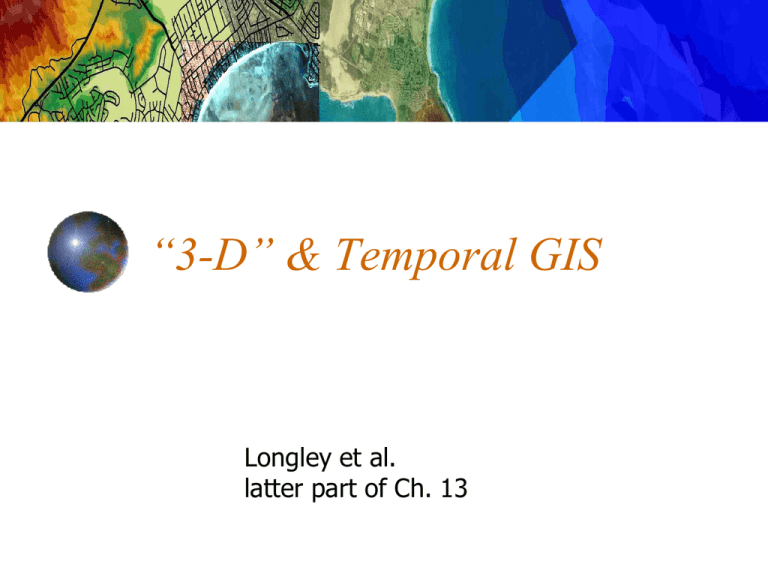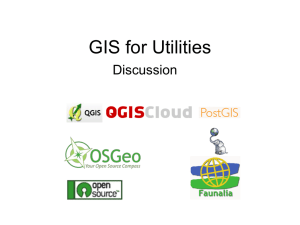“3-D” & Temporal GIS
advertisement

“3-D” & Temporal GIS Longley et al. latter part of Ch. 13 Horizontal sure, but …. how to deal with elevation/depth or time Vertical Horizontal and vertical Horizontal, vertical, and time ArcScene 9 Demo http://dusk.geo.orst.edu/gis/captivate_arcscene/arcscene_demo.htm The Vertical Dimension two very different ways of looking at representations of the vertical dimension (third dimension) in GIS “2.5-D” and “3-D” vertical dimension combined with temporal query = “4-D” Lab 7 on Temporal Mapping Tutorial/Exercises 6-2 and 6-3 Please answer STUDY QUESTIONS too! Read instructions carefully Use ArcCatalog not Windows Explorer! Layouts please, not screen snapshots The geodatabase http://dusk.geo.orst.edu/gis/geodatabaseCampus.mp4 Time Dependence time dependence adds a third dimension to spatial data, just as the vertical dimension does or may be added to 3 spatial dimensions to give 4D Coastal Evolution of OR/WA Cross & Twichell, USGS Woods Hole in Wright (ed.) Undersea with GIS, ESRI Press, 2002. Time and Geographical Data computer science has dealt with time dependence of records in databases e.g., records may be valid only for limited times geographical cases are more complex objects may have limited existence, but may also move, change shape, and change attributes database models for time? few “temporal GISs” on the market Tracking Analyst for ArcGIS Dealing with Time in GIS shape of objects same, but attributes change (ESPN) same shape, same attributes, but boundaries between objects or locations of objects change Turn on/off or move http://www.clockwk.com/centenniavid.htm shapes of objects change through time define a limited number of time "slices" “2.5 D” most common way of “doing 3D” in commercial GIS packages z value (normally elevation) is recorded as an attribute for each data point (x,y) z values can be used in a perspective plot to create the appearance of 3 dimensions not true 3-D representation because elevation is not encoded in data structure, not in topology 2.5 D Representations attractive displays of topography and other continuous surfaces from DEMs or TINs perspective plots computed from any viewpoint additional layers "draped" over the surface USGS Topography “Coastal Terrain Model” …a surface that integrates topography Integrated Topo-Bathy Model and bathymetry Topography Bathymetry + = Satellite Imagery Draped on Topo-bathy model A dense network of Wi-Fi infrastructure viewed above the built environment of Salt Lake City, Utah (Courtesy Paul Torrens) Boundary Representation TIN is a 2.5 D type of B-rep one value of z for every x,y each object has faces, edges, points Perspective Plot from TIN (2.5-D B-Rep) B-Rep of a Cave Passage True 3-D store data in structures that actually reference locations in 3D space (x,y,z) here z is not an attribute but an element of the location of the point if z is missing, object does not exist! several z’s possible for a single x-y pair, soundings in the ocean or atmosphere, geologic logs of wells 3-D Applications geological/geophysical exploration engineering design of mines, quarries, dams, reservoirs, etc. scientific explanation of 3D processes such as ocean currents or lava flows “data driven” - may not necessarily know what you will find in 3D so the structure of the representation may enhance types of analyses that can be performed Fonseca, Mayer, and Paton in Wright (ed.) Undersea with GIS published by ESRI Press Fonseca, Mayer, and Paton in Wright (ed.) Undersea with GIS published by ESRI Press “Fledermaus” Interactive Visualization Systems www.ivs3d.com http://dusk.geo.orst.edu/gis/captivate_ivs/ivs1.htm http://dusk.geo.orst.edu/gis/captivate_ivs/ivs2.htm http://dusk.geo.orst.edu/gis/captivate_ivs/ivs3.htm Volumes visualization of volumes modeling of volumes algorithms for 3D spatial analysis simpler, more efficient, if data in a volumetric form Example two: Hydrothermal Plume model output VTK/Java3D allows volume calculations, rendering, and analysis. 3D probe ● animation ● bathymetry ● multibeam ● Smith/Sandwell ● Vance et al., NOAA Alaska Fisheries Science Center Becker, Science, August 27, 2010 Underwater Behavior of Humpback Whales: Potential Entanglement in Fishing Gear Stellwagen Bank National Marine Sanctuary - Ware et al., Center for Coastal and Ocean Mapping, U. of New Hampshire Spatial Occupancy Enumeration (SOE) volume is divided into cubes or voxels usually produced by converting from Breps (similar to converting vectors to rasters in 2D) mass, volume and surface area are quickly computed as Boolean operations [on (full) / off (empty)] or voxel counts SOE of a Mine/Quarry Surface Water Runoff Gold, Transactions in GIS, 2006 Commercially Available? Research frontier not too many truly 3D GIS packages on the market 2- or 2.5D GIS linked to 3D modeling package You knew I had to mention it… GOOGLE EARTH A 3-D representation of office and retail land use in London. The height of the bars identifies ’rateable value’—a UK indicator of the value of the property/real estate in the grid squares–that is dedicated to office and retail functions. (Courtesy Duncan Smith: data © Valuation Office Agency 2005) An extruded 3-D map of Figure 13.16, embedded within a games engine (Courtesy Andy Hudson-Smith) A collaborative planning application in Second Life, using elements of the Virtual London 3-D model (www.secondlife.com) (Courtesy Andy Hudson-Smith) My Avatar Sketch Ups and Touch Tables Insert your own objects Google Ocean “Visualize” with your hands http://www.youtube.com/watch?v=X2pPe W4cUgU&feature=PlayList&p=FB02B6AD3 5983A48&playnext=1&index=14 http://www.youtube.com/watch?v=W3dz2 xpCJVU&feature=related A 3-D building representation, created using Google Sketchup and suitable for inclusion in a 3-D city model






